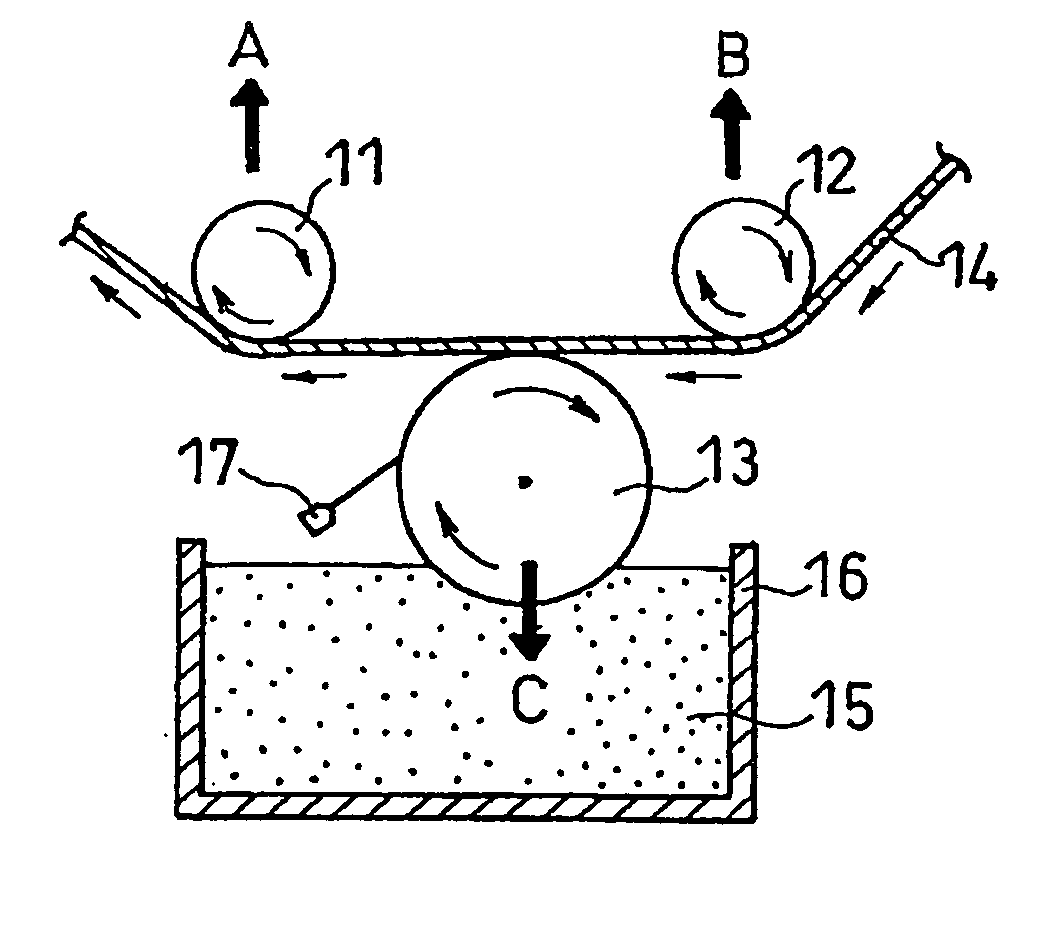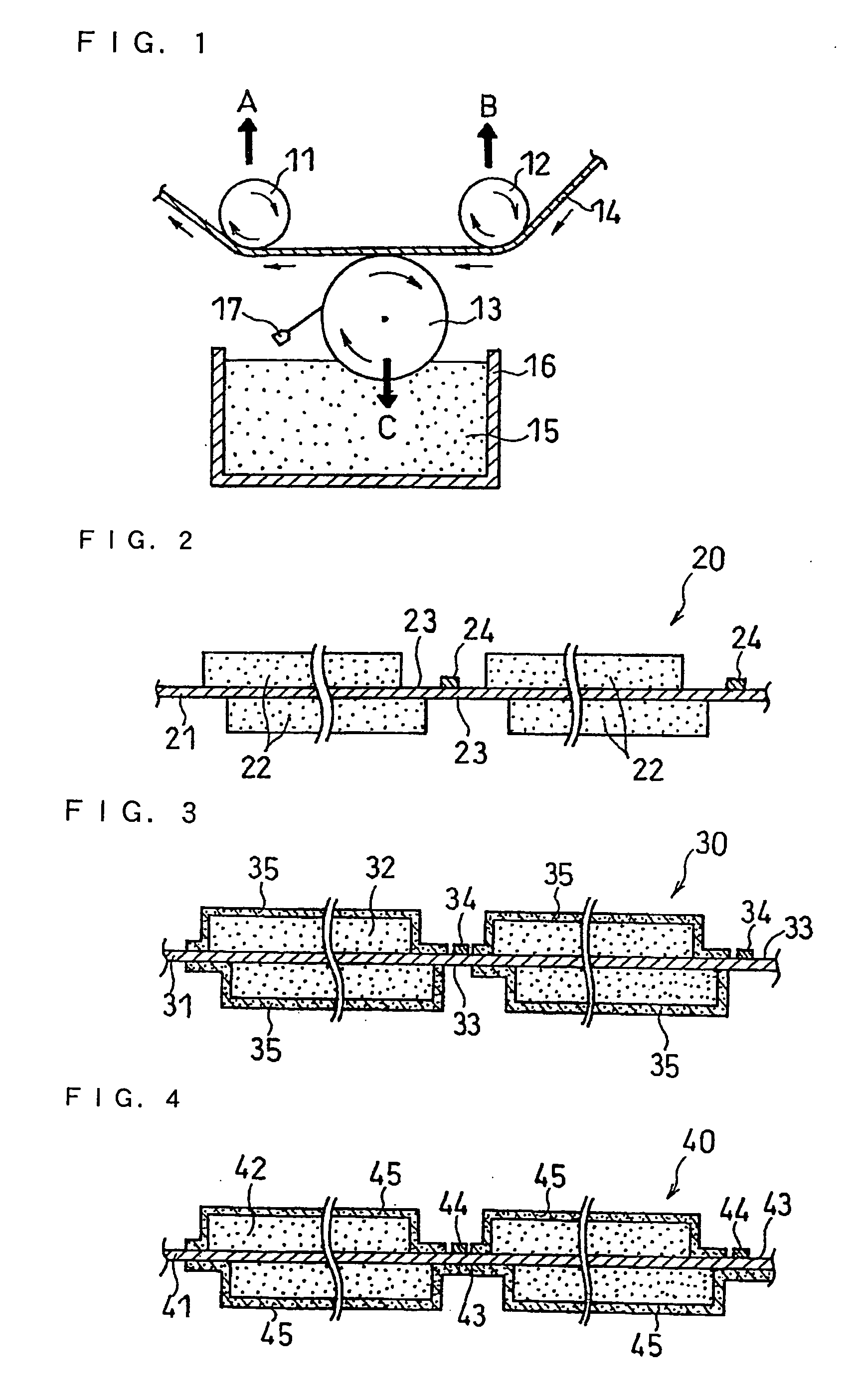Method for producing lithium ion secondary battery
a lithium ion secondary battery and lithium ion technology, applied in the direction of sustainable manufacturing/processing, non-aqueous electrolyte cells, cell components, etc., can solve problems such as internal short-circuits, and achieve excellent cycle characteristics, uniform thickness, and enhanced functions of preventing short-circuits and expansion of short-circuits
- Summary
- Abstract
- Description
- Claims
- Application Information
AI Technical Summary
Benefits of technology
Problems solved by technology
Method used
Image
Examples
example 1
[0084] Using an application device as illustrated in FIG. 1, a slurry containing an inorganic oxide filler and a resin binder prepared in the same manner as in Comparative Example 2 was intermittently applied to one surface of a negative electrode sheet prepared in the same manner as in Comparative Example 1 so as to exclude the lead-forming parts, and it was then dried to form 20 μm-thick porous insulating layers. Likewise, porous insulating layers were formed on the other surface of the negative electrode sheet.
[0085] The application device used was equipped with a gravure roll having grooves at pitches of 100 lines / inch on the outer surface thereof, the grooves being tilted at 45° C. The rotation speed of the outer surface of the gravure roll was set to 150% of the transportation speed of the negative electrode sheet. The transportation speed of the negative electrode sheet by the guide rolls was set to 10 m / min. The traveling direction of the outer surface of the gravure roll w...
example 2
[0088] In the same manner as in Example 1, a slurry containing an inorganic oxide filler and a resin binder was intermittently applied to one surface of a negative electrode sheet so as to exclude the lead-forming parts, and it was then dried to form 20 μm-thick porous insulating layers. On the other hand, a porous insulating layer was formed on the whole of the other surface of the negative electrode sheet by continuous application.
[0089] Subsequently, a negative electrode lead was welded to each of the lead-forming parts. A cylindrical lithium ion secondary battery of size 18650 was completed in the same manner as in Comparative Example 1 except for the use of the negative electrode sheet thus obtained.
[0090]FIG. 4 is a schematic sectional view of a negative electrode sheet 40 with porous insulating layers obtained in this example.
[0091] Negative electrode material mixtures 42 are carried on both sides of a copper foil sheet 41 serving as a core member. Exposed parts 43 of the ...
example 3
[0092] A slurry containing an inorganic oxide filler and a resin binder was intermittently applied to the surfaces of a negative electrode sheet so as to exclude the lead-forming parts and was then dried to form 20 μm-thick porous insulating layers in the same manner as in Example 1, except that the traveling direction of the outer surface of the gravure roll was made the same as the traveling direction of the negative electrode sheet.
[0093] Subsequently, a negative electrode lead was welded to each of the lead-forming parts. A cylindrical lithium ion secondary battery of size 18650 was completed in the same manner as in Comparative Example 1 except for the use of the negative electrode sheet thus obtained.
[Evaluation]
[0094] The batteries of Examples 1 to 3 and Comparative Examples 1 to 3 were evaluated in the following manner. Table 1 shows the result.
(Battery Resistance)
[0095] Each battery was subjected to a break-in charge / discharge twice and then measured for its impedance...
PUM
| Property | Measurement | Unit |
|---|---|---|
| transportation speed | aaaaa | aaaaa |
| viscosity | aaaaa | aaaaa |
| temperature | aaaaa | aaaaa |
Abstract
Description
Claims
Application Information
 Login to View More
Login to View More - R&D
- Intellectual Property
- Life Sciences
- Materials
- Tech Scout
- Unparalleled Data Quality
- Higher Quality Content
- 60% Fewer Hallucinations
Browse by: Latest US Patents, China's latest patents, Technical Efficacy Thesaurus, Application Domain, Technology Topic, Popular Technical Reports.
© 2025 PatSnap. All rights reserved.Legal|Privacy policy|Modern Slavery Act Transparency Statement|Sitemap|About US| Contact US: help@patsnap.com


